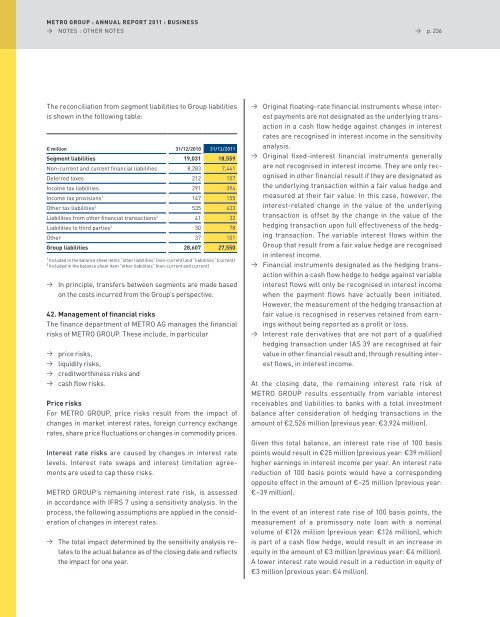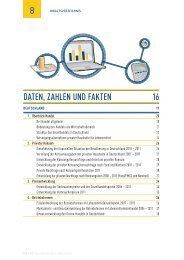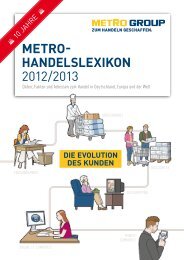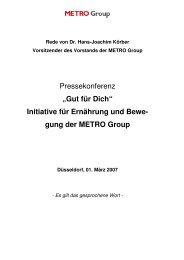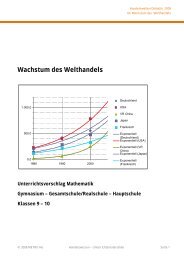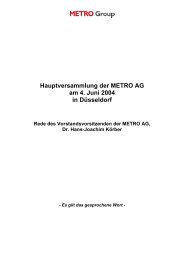pdf (22.8 MB) - METRO Group
pdf (22.8 MB) - METRO Group
pdf (22.8 MB) - METRO Group
Create successful ePaper yourself
Turn your PDF publications into a flip-book with our unique Google optimized e-Paper software.
<strong>METRO</strong> gROUP : ANNUAL REPORT 2011 : BUsiNEss<br />
→ noTes : oTHeR noTes<br />
The reconciliation from segment liabilities to <strong>Group</strong> liabilities<br />
is shown in the following table:<br />
€ million 31/12/2010 31/12/2011<br />
segment liabilities 19,031 18,559<br />
non-current and current financial liabilities 8,283 7,441<br />
Deferred taxes 212 157<br />
Income tax liabilities 291 394<br />
Income tax provisions1 147 155<br />
other tax liabilities2 535 633<br />
liabilities from other financial transactions2 41 32<br />
liabilities to third parties2 30 78<br />
other 37 101<br />
group liabilities 28,607 27,550<br />
1 Included in the balance sheet items “other liabilities” (non-current) and “liabilities” (current)<br />
2 Included in the balance sheet item “other liabilities” (non-current and current)<br />
→ In principle, transfers between segments are made based<br />
on the costs incurred from the <strong>Group</strong>’s perspective.<br />
42. Management of financial risks<br />
The finance department of MeTRo aG manages the financial<br />
risks of MeTRo GRoUp. These include, in particular<br />
→ price risks,<br />
→ liquidity risks,<br />
→ creditworthiness risks and<br />
→ cash flow risks.<br />
Price risks<br />
For MeTRo GRoUp, price risks result from the impact of<br />
changes in market interest rates, foreign currency exchange<br />
rates, share price fluctuations or changes in commodity prices.<br />
Interest rate risks are caused by changes in interest rate<br />
levels. Interest rate swaps and interest limitation agreements<br />
are used to cap these risks.<br />
MeTRo GRoUp’s remaining interest rate risk, is assessed<br />
in accordance with IFRs 7 using a sensitivity analysis. In the<br />
process, the following assumptions are applied in the consideration<br />
of changes in interest rates:<br />
→ The total impact determined by the sensitivity analysis relates<br />
to the actual balance as of the closing date and reflects<br />
the impact for one year.<br />
→ p. 236<br />
→ original floating-rate financial instruments whose interest<br />
payments are not designated as the underlying transaction<br />
in a cash flow hedge against changes in interest<br />
rates are recognised in interest income in the sensitivity<br />
analysis.<br />
→ original fixed-interest financial instruments generally<br />
are not recognised in interest income. They are only recognised<br />
in other financial result if they are designated as<br />
the underlying transaction within a fair value hedge and<br />
measured at their fair value. In this case, however, the<br />
interest-related change in the value of the underlying<br />
transaction is offset by the change in the value of the<br />
hedging transaction upon full effectiveness of the hedging<br />
transaction. The variable interest flows within the<br />
<strong>Group</strong> that result from a fair value hedge are recognised<br />
in interest income.<br />
→ Financial instruments designated as the hedging transaction<br />
within a cash flow hedge to hedge against variable<br />
interest flows will only be recognised in interest income<br />
when the payment flows have actually been initiated.<br />
However, the measurement of the hedging transaction at<br />
fair value is recognised in reserves retained from earnings<br />
without being reported as a profit or loss.<br />
→ Interest rate derivatives that are not part of a qualified<br />
hedging transaction under Ias 39 are recognised at fair<br />
value in other financial result and, through resulting interest<br />
flows, in interest income.<br />
at the closing date, the remaining interest rate risk of<br />
MeTRo GRoUp results essentially from variable interest<br />
receivables and liabilities to banks with a total investment<br />
balance after consideration of hedging transactions in the<br />
amount of €2,526 million (previous year: €3,924 million).<br />
Given this total balance, an interest rate rise of 100 basis<br />
points would result in €25 million (previous year: €39 million)<br />
higher earnings in interest income per year. an interest rate<br />
reduction of 100 basis points would have a corresponding<br />
opposite effect in the amount of €–25 million (previous year:<br />
€–39 million).<br />
In the event of an interest rate rise of 100 basis points, the<br />
measurement of a promissory note loan with a nominal<br />
volume of €126 million (previous year: €126 million), which<br />
is part of a cash flow hedge, would result in an increase in<br />
equity in the amount of €3 million (previous year: €4 million).<br />
a lower interest rate would result in a reduction in equity of<br />
€3 million (previous year: €4 million).


